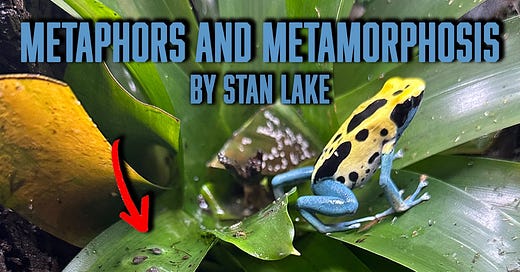Most of my creative life has revolved around metamorphosis and metaphors. I love telling stories, and stories with a transformative ending are even better. As I was steeping in a hot bath, those words came to me. My brain felt like Jello for most of the last few weeks. So, any inkling or idea worth expounding upon is a welcome cause for celebration. And here we are with words clacking at a moderate pace on this ancient keyboard.
I could go on about how stressful work has been, or how I’ve dug mass-grave-sized holes in my backyard and filled them with boulders I moved by hand, but why? We are likely all dealing with innumerable major and minor stressors in our daily lives, so why share a burden that will likely pass with the season, as they always do? So, let’s talk about metamorphosis.
Walking in my basement jungle, I peeked into a poison dart frog terrarium and was overjoyed to see eggs. They laid two batches of eggs on separate leaves of a bromeliad plant. The eggs were at different stages of development, and I was shocked that I’d somehow missed them. I didn’t think to look in that location since they typically lay eggs under coconut huts that I’ve positioned in the terrariums with egg deposition sites.
It’s pretty neat actually, a halved coconut hut with a little “door” cut into the front of it is placed over a petri dish with a pothos leaf in it, and typically the dart frogs will lay five to ten eggs in that spot. This makes breeding them easy; all I have to do is swap out the petri dishes when they lay, take the eggs to the other side of the room, and wait for them to transform into tadpoles. Once they hatch from their gelatinous globules, I put each tadpole in tannin-rich water inside a thirty-two-ounce container. I raise them individually because some dart frog tadpoles can be cannibalistic.
In the wild, many dart frogs—often the males—carry the tadpoles on their backs and deposit them in the funnels of bromeliads. Bromeliads are what’s called an epiphytic plant—sometimes called air plants—they will attach themselves in the crooks of trees, and their funnels fill with water. This makes the perfect environment for developing tadpoles. The rainwater flushes out the foul water in the plants, as well as depositing insects and algae for them to eat. In captivity, they get a mix of various pellets and commercial algae wafers with frequent water changes in their cups.
Magically, after a few months, the tadpoles develop first back legs, then front legs. Their tails absorb, their gills turn into lungs, and their mouthparts change. It’s as if they are a completely new creature. In many ways, they are. What was once an aquatic algae sucker turns into a hopping insect eater. I love being reminded of the nuances of all the ways they change before becoming who they were meant to be. This is where the metaphor portion comes in.
How many times in our lives do we get hung up on the various phases of life we are stuck in? Whether it’s a busy season or a stagnant one, it’s all part of the process of becoming. I often wonder if the tadpole with only vestigial back limbs gets frustrated that he can’t leap like others can. At that phase in his life, the back legs are useless. Little does he know that this inconvenient change will be part of his biggest victory. So, when I get bummed out that things aren’t happening fast enough for my microwaved mind, I have to remember the frogs. This, too, shall pass. Minor hardships or inconvenient limbs are all part of the journey to being fully formed.





Beautifully inspiring to this spiritually aware, nature addict!
Nothing short of miracle